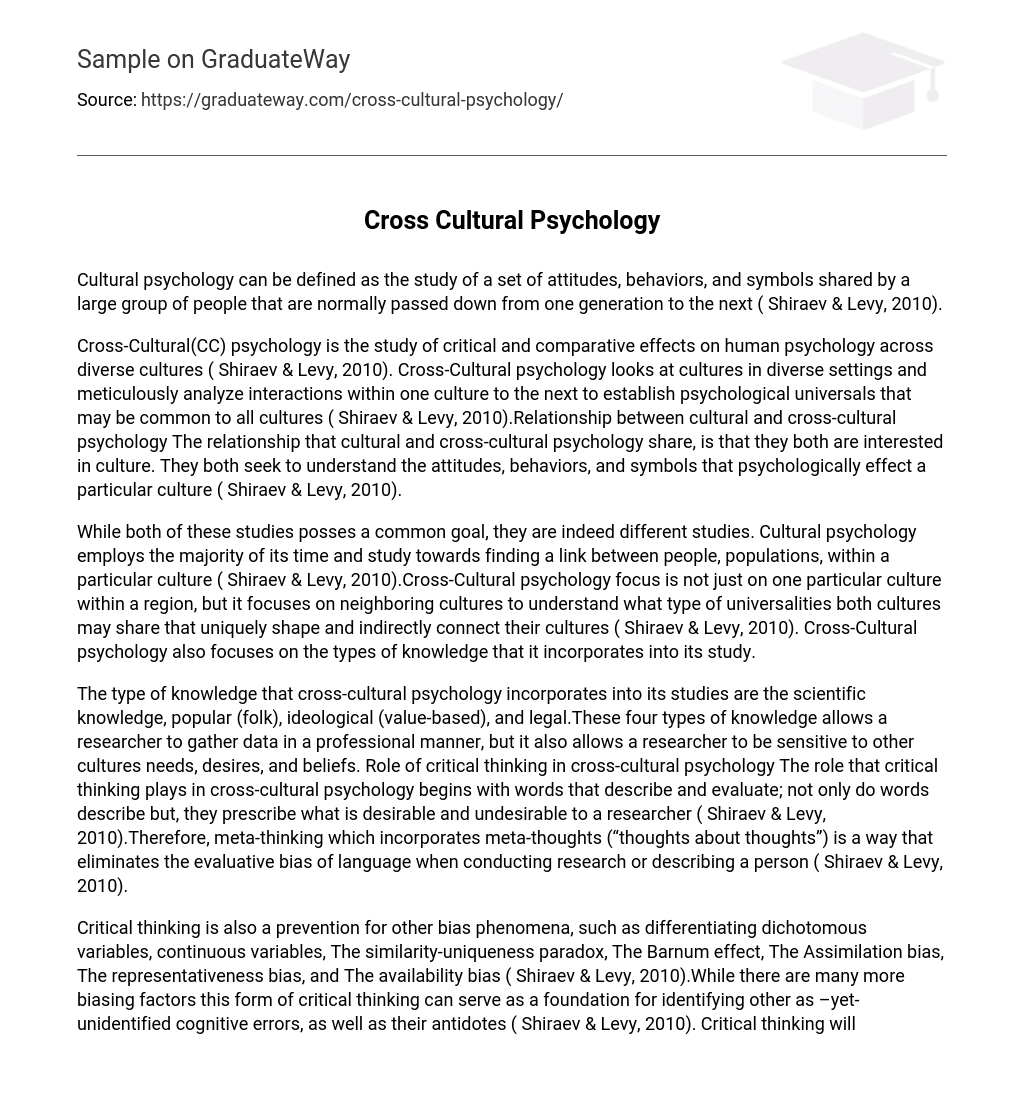Cultural psychology can be defined as the study of a set of attitudes, behaviors, and symbols shared by a large group of people that are normally passed down from one generation to the next ( Shiraev & Levy, 2010).
Cross-Cultural(CC) psychology is the study of critical and comparative effects on human psychology across diverse cultures ( Shiraev & Levy, 2010). Cross-Cultural psychology looks at cultures in diverse settings and meticulously analyze interactions within one culture to the next to establish psychological universals that may be common to all cultures ( Shiraev & Levy, 2010).Relationship between cultural and cross-cultural psychology The relationship that cultural and cross-cultural psychology share, is that they both are interested in culture. They both seek to understand the attitudes, behaviors, and symbols that psychologically effect a particular culture ( Shiraev & Levy, 2010).
While both of these studies posses a common goal, they are indeed different studies. Cultural psychology employs the majority of its time and study towards finding a link between people, populations, within a particular culture ( Shiraev & Levy, 2010).Cross-Cultural psychology focus is not just on one particular culture within a region, but it focuses on neighboring cultures to understand what type of universalities both cultures may share that uniquely shape and indirectly connect their cultures ( Shiraev & Levy, 2010). Cross-Cultural psychology also focuses on the types of knowledge that it incorporates into its study.
The type of knowledge that cross-cultural psychology incorporates into its studies are the scientific knowledge, popular (folk), ideological (value-based), and legal.These four types of knowledge allows a researcher to gather data in a professional manner, but it also allows a researcher to be sensitive to other cultures needs, desires, and beliefs. Role of critical thinking in cross-cultural psychology The role that critical thinking plays in cross-cultural psychology begins with words that describe and evaluate; not only do words describe but, they prescribe what is desirable and undesirable to a researcher ( Shiraev & Levy, 2010).Therefore, meta-thinking which incorporates meta-thoughts (“thoughts about thoughts”) is a way that eliminates the evaluative bias of language when conducting research or describing a person ( Shiraev & Levy, 2010).
Critical thinking is also a prevention for other bias phenomena, such as differentiating dichotomous variables, continuous variables, The similarity-uniqueness paradox, The Barnum effect, The Assimilation bias, The representativeness bias, and The availability bias ( Shiraev & Levy, 2010).While there are many more biasing factors this form of critical thinking can serve as a foundation for identifying other as –yet- unidentified cognitive errors, as well as their antidotes ( Shiraev & Levy, 2010). Critical thinking will also help eliminate other biasing effects and allow a cross-cultural psychologists to improve the clarity of thinking and accuracy to problems while opening pathways to new perspectives and alternative points of view ( Shiraev & Levy, 2010).Methodology associated with cross-cultural psychology The methodologies that have been associated with cross-cultural psychology is based on four basic goals of research that are descriptive, interpretive, predictive and effectiveness ( Shiraev & Levy, 2010).
Once a researcher is able to conduct an effective investigation using these four basic goals of research, then the research methodologies can be implemented.The research methodologies that are widely adapted by cross-cultural psychologists can be divided into two categories and are qualitative and quantitative research ( Shiraev & Levy, 2010). Qualitative form of research involves a researcher collecting data of the observed in their natural settings to try and detect some illicit or unspoken cultural norms that would be hard to detect with standard quantitative methods of research ( Shiraev & Levy, 2010).Another form of qualitative research that is commonly known as psychobiographical research takes the approach of conducting an in-depth analysis of a particular individual that usually holds a higher social status (i.
e. celebrity, leader, etc. ) representing different countries or cultures. Most of the evidence that is collected during this type of study is empirical evidence and is used to build a personal profile that reveals how behavior is formed and transformed under cultural conditions ( Shiraev & Levy, 2010).
Quantitative is the second form of research that is widely used throughout psychology and cross-cultural psychology. Quantitative research involves measurement of human activity from a comparative perspective and must be studied empirically instead of being studied through other forms of reflection, intuition, beliefs, or superstitions ( Shiraev & Levy, 2010). The most common collection of data for a quantitative study is through the measures of central tendency (mode, mean, median).This form of collecting data and empirical evidence allows cross-cultural psychology to use statistical methods that can establish relationships between two variables or cultures ( Shiraev & Levy, 2010).
Cross-Cultural psychologists also have research strategies to use when performing experiments. The first strategy is the application oriented strategy and it involves researchers attempting to establish the applicability of research findings in one country and or culture to other countries and cultures ( Shiraev & Levy, 2010).The second research strategy is the comparativist strategy and this strategy focuses on similarities and differences of different cultures based on statistical measures ( Shiraev & Levy, 2010). Both qualitative and quantitative research provides reliable data for cross-cultural psychologist that can be analyzed and help explain social norms between cultures that may not be apparent to different cultures.
Conclusion In conclusion, cultural psychology is a fairly new branch of psychology, but it has set forth to investigate and explain cultures and the similarities that intertwines us as humans hroughout different cultures. Cross- cultural psychology incorporates the scientific method into its studies but it is also sensitive enough to take in concerns of cultural knowledge (popular and ideological) beliefs to help understand factors that may shape cultures. Although cultural psychology and cross-cultural psychology share the word culture and often look at the same phenomena’s, cross-cultural psychology has earned its right to be a separate division of study within psychology.ReferencesShiraev, E.
B., & Levy, D.A. (2010).
Cross-cultural psychology. Retrieved from https://ecampus.phoenix.edu/content/eBookLibrary2/content/DownloadList.aspx?assetMetaId=ac0b2e56-5cb2-4024-abff-6da6accc415c&assetDataId=af8cd5b2-eb6b-4784-96f1-335d27ddf117.





